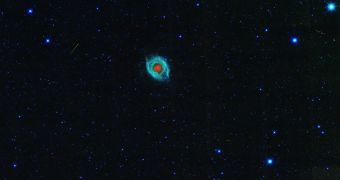While browsing through data collected by the NASA Wide-Field Infrared Survey Explorer (WISE), scientists at the American space agency's Jet Propulsion Laboratory (JPL), in Pasadena, California, uncovered a bizarre image that depicts a distant nebula surrounded by nearby asteroid tracks.
The infrared space telescope is currently celebrating its fourth anniversary, after officials at NASA Headquarters, in Washington DC announced that they would continue to support a revamped version of its original mission in the years to come.
Whereas WISE was originally used to map the night sky, its new mission, dubbed NEOWISE, will be focused on identifying asteroids and meteorites within our own solar system that may pose a threat to Earth – the so-called Near Earth Object (NEO) group.
While looking for signs of NEO asteroids in archival WISE data, the JPL team stumbled across the image attached to this article, which shows the distant cosmic object surrounded by tracks left in NEOWISE's field of view by asteroids roaming within our own solar system.
The juxtaposition is nothing more than a happy coincidence, the astronomers say. Helix, also known as NGC 7293 or the Eye of God, is a large planetary nebula that lies in the constellation Aquarius, around 695 light-years away. It is one of the nearest planetary nebulae to our solar system.
“I was recently looking for asteroids in images collected in 2010, and this picture jumped out at me. I recognized the Helix nebula right away,” says Amy Mainzer, who holds an appointment as the principal investigator of the NEOWISE mission at JPL.
“WISE is the spacecraft that keeps on giving,” comments University of California in Los Angeles (UCLA) professor Ned Wright, who was the principal investigator for WISE during its original mission.
In addition to asteroids in the solar system, some of the streaks and dots in this image represent satellites orbiting our own planet, as well as some traces of cosmic rays.
WISE was built by Ball Aerospace, Lockheed Martin, the Space Dynamics Laboratory, and SSG Precision Optronics, Inc., and launched into space on December 14, 2009, from the Vandenberg Air Force Base, in California.
The satellite was injected on its Sun-synchronous polar orbit by a Delta II delivery system, at an average altitude of 525 kilometers (326 miles). WISE's original mission concluded on February 17, 2011, and the spacecraft was reactivated on August 21, 2013.

 14 DAY TRIAL //
14 DAY TRIAL //